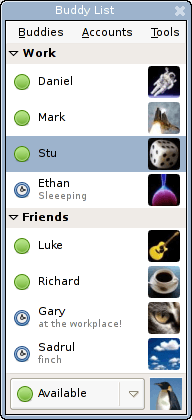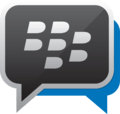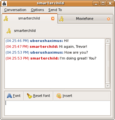Instant messaging facts for kids

Instant messaging (often called IM) is a way for people to chat with each other by typing messages. These messages are sent instantly using computers over a network like the Internet.
To use instant messaging, you need a special program called an instant messaging client. This program connects to a service that sends your messages. IM is different from e-mail because your conversations happen right away, in real-time. Some apps let you connect to many different IM networks at once. Instant messaging ideas came from older online chat systems like Internet Relay Chat (IRC).
Contents
Why People Use Instant Messaging
Instant messaging lets you talk to friends or classmates right away. It feels more like a real conversation than sending emails. You can also see if someone is online and available to chat. Most IM apps let you set your online status or an away message. This tells your friends if you are available, busy, or away from your computer.
But you don't have to reply instantly if you don't want to! Many people find IM less pushy than a phone call. Instant messaging also lets many people chat together at the same time. Some apps even let you see the other person using a webcam or talk to them for free over the internet.
A Quick Look at IM History
Instant messaging programs first appeared in the 1970s. They were used on big computer systems to help people on the same computer talk to each other. Later, they worked across local networks and then the whole Internet.
The IM apps we know today, with their easy-to-use screens, started becoming popular in the mid-1990s. ICQ was one of the first, launched in 1996. Then came AOL Instant Messenger in 1997. After that, many other companies made their own chat apps, like Yahoo!, MSN, and IBM.
Who Uses Instant Messaging?
Lots and lots of people use instant messaging! Billions of messages are sent every day. Many popular apps have hundreds of millions of users. Here are some of the most used instant messaging apps:
- Facebook Messenger
- Tencent QQ
- Telegram
- Skype
- Viber
- Line
- Discord
- Snapchat
- iMessage (for Apple users)
These apps help people stay connected with friends, family, and classmates all over the world.
Related Pages
Images for kids
-
A buddy list on Pidgin
-
Facebook Chat, an example of IM through a social network.
See also
 In Spanish: Mensajería instantánea para niños
In Spanish: Mensajería instantánea para niños








